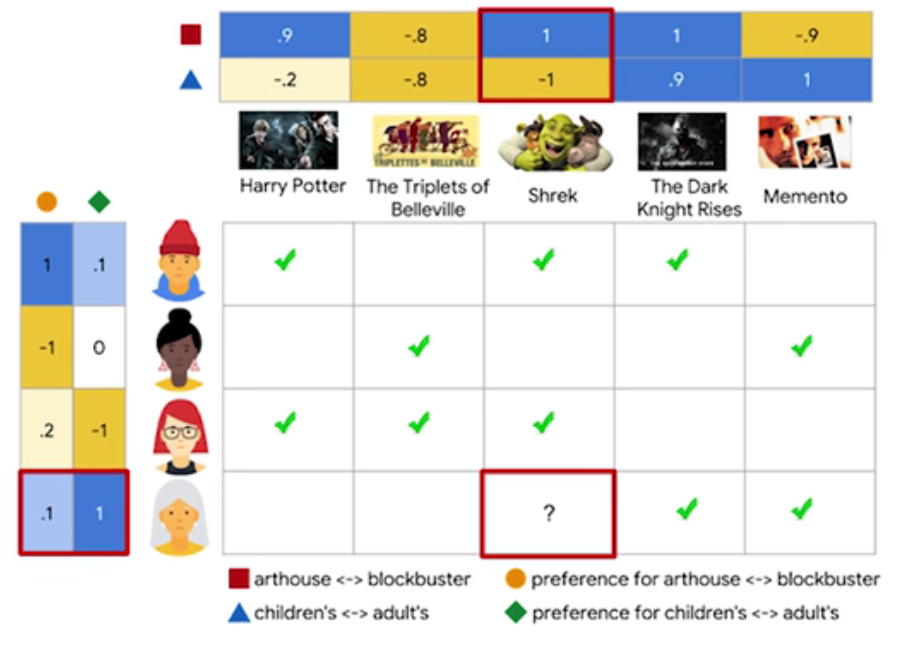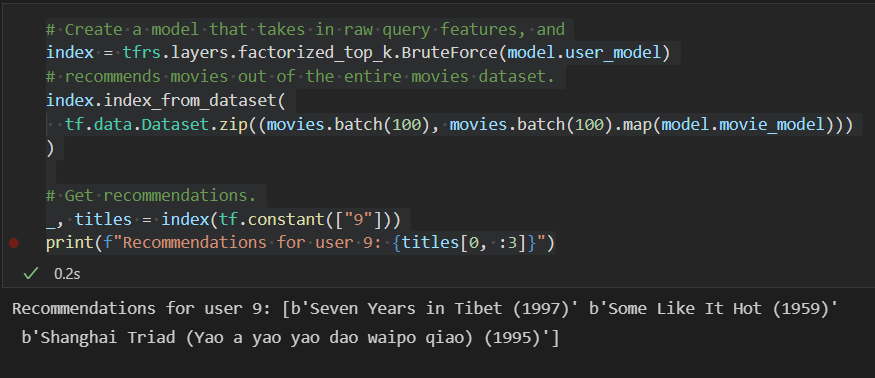---
template: overrides/blogs.html
tags:
- deep learning
- tensorflow
- recommendation
---
# TensorFlow推荐系统(一)
!!! info
作者:Tina,发布于2021-12-10,阅读时间:约6分钟,微信公众号文章链接:[:fontawesome-solid-link:](https://mp.weixin.qq.com/s/OUsG-JqqYeh9q6oAa_uhmg)
## 1 前言
我们浏览在各个平台时会发现"为你推荐"功能。比如YouTube推荐爱看的视频,音乐软件为你提供你可能喜欢的音乐等。其实这一功能的背后涉及的原理就是人工智能的推荐系统。今天我们将介绍TensorFlow推荐系统模型的库——[TensorFlow Recommenders(TFRS)](https://www.tensorflow.org/recommenders?hl=en 'TensorFlow Recommenders')。
对TensorFlow感兴趣的朋友们,还可以回顾我们之前相关的文章:
- [Keras各种Callbacks介绍](https://mp.weixin.qq.com/s/N3_1lJ_a1gAVLyqsXUwN9Q)
- [使用tf.keras自定义模型](https://mp.weixin.qq.com/s/z2uBxwe8UNDXWMDNS_k-Gg)
- [在Apple Silicon Macs上安装TensorFlow](https://mp.weixin.qq.com/s/QHZW_lcMo_nPQWDYPDGREg)
- [读《30天吃掉那只TensorFlow2》](https://mp.weixin.qq.com/s/cw2DW7al5nJV93roAN_gwg)
## 2 推荐原理
这里我们用电影推荐的例子来讲解推荐系统的原理。
对于现有的四个用户和五部类型不同的电影,首先,我们需要创建用户画像和定义电影类别,这一步是为了区分数据,将现实特征转化为可计算的变量。对于现有的用户数据和电影数据,我们如何给用户D推荐她可能喜欢的电影呢?
 如下图所示,这里我们为用户和电影两个变量各自创建两个维度的矩阵。对于用户,我们将定义是否偏爱儿童电影(-1表示很喜欢儿童电影,1则相反)和是否偏爱火爆电影(1表示很喜欢火爆电影,-1相反);对于电影,这里定义是否是儿童电影(-1表示儿童电影,1则表示非儿童电影)和是否是火爆电影(1表示火爆电影,-1则反然)。
可以看出,用户A很喜欢看儿童且火爆的电影,这就是基于两个维度的`User Embedding`;而《怪物史莱克》在这里被定义为儿童且火爆的电影,这一过程就是`Movie Embedding`。值得一提的是,在搭建模型时,`Embedding`的维度不只是二维的,往往是多维的矩阵来表示变量。
如下图所示,这里我们为用户和电影两个变量各自创建两个维度的矩阵。对于用户,我们将定义是否偏爱儿童电影(-1表示很喜欢儿童电影,1则相反)和是否偏爱火爆电影(1表示很喜欢火爆电影,-1相反);对于电影,这里定义是否是儿童电影(-1表示儿童电影,1则表示非儿童电影)和是否是火爆电影(1表示火爆电影,-1则反然)。
可以看出,用户A很喜欢看儿童且火爆的电影,这就是基于两个维度的`User Embedding`;而《怪物史莱克》在这里被定义为儿童且火爆的电影,这一过程就是`Movie Embedding`。值得一提的是,在搭建模型时,`Embedding`的维度不只是二维的,往往是多维的矩阵来表示变量。
 接下来,用矩阵分解进行协同过滤计算预测的反馈矩阵。如下图所示,U代表用户矩阵,V代表电影候选条目的矩阵,计算的A值就是预测的反馈值。所以`协同过滤`就是依据用户和候选条目之间的相似度来进行推荐。
接下来,用矩阵分解进行协同过滤计算预测的反馈矩阵。如下图所示,U代表用户矩阵,V代表电影候选条目的矩阵,计算的A值就是预测的反馈值。所以`协同过滤`就是依据用户和候选条目之间的相似度来进行推荐。
 在使用矩阵分解进行协同过滤时,为了减少目标函数的预测误差,官方解释使用随机梯度下降`Stochastic Gradient Descent(SGD)`或加权交替最小平方算法`Weighted Alternating Least Squares(WALS)`两种方式。
值得一提的是,WALS是专门解决推荐系统而创建的新算法,与前者不同,WALS每次迭代时,固定U的值来确定V,再固定V的值来确定U。两种方法各有利弊,这里不再详细介绍了,感兴趣的朋友可以学习一下[矩阵分解](https://developers.google.com/machine-learning/recommendation/collaborative/matrix 'Matrix Factorization')的官方资料.
在使用矩阵分解进行协同过滤时,为了减少目标函数的预测误差,官方解释使用随机梯度下降`Stochastic Gradient Descent(SGD)`或加权交替最小平方算法`Weighted Alternating Least Squares(WALS)`两种方式。
值得一提的是,WALS是专门解决推荐系统而创建的新算法,与前者不同,WALS每次迭代时,固定U的值来确定V,再固定V的值来确定U。两种方法各有利弊,这里不再详细介绍了,感兴趣的朋友可以学习一下[矩阵分解](https://developers.google.com/machine-learning/recommendation/collaborative/matrix 'Matrix Factorization')的官方资料.
 ## 3 源码解析
现实推荐系统分为两大部分:
1. 从大量的潜在推荐条目中选择可能性比较大的items,这一过程叫做信息检索(retrieval)。
2. 对于提取模型的结果,我们还需要排序来缩小选择最有可能被用户选择的items,这一过程叫做rank。
这一部分,我们先介绍第一阶段的信息提取模型。信息提取模型又包含两个子模型,查询模型和候选模型,对应上述的例子就是用户矩阵和候选条目矩阵,通过计算两个子模型的乘积,得到的`query-candidate affinity score`就是反映查询和候选条目之间的匹配程度,即用户喜欢推荐条目的可能性。
```Python
# Dependency install
!pip install -q tensorflow-recommenders
!pip install -q --upgrade tensorflow-datasets
import os
import pprint
import tempfile
from typing import Dict, Text
import numpy as np
import tensorflow as tf
import tensorflow_datasets as tfds
## import tensorflow recommenders API
import tensorflow_recommenders as tfrs
```
从网上加载`MovieLens`数据:
```Python
# Ratings data.
ratings = tfds.load("movielens/100k-ratings", split="train")
# Features of all the available movies.
movies = tfds.load("movielens/100k-movies", split="train")
## Note: MovieLens 没有事先准备好数据集,所有的数据都在train data中。
# 查看数据rating和movies
for x in ratings.take(2).as_numpy_iterator():
pprint.pprint(x)
#{'movie_title': b"One Flew Over the Cuckoo's Nest (1975)", 'user_id': b'138'}
#{'movie_title': b'Strictly Ballroom (1992)', 'user_id': b'92'}
for x in movies.take(2).as_numpy_iterator():
pprint.pprint(x)
#b'You So Crazy (1994)'
#b'Love Is All There Is (1996)'
```
在提取模型中,我们先处理`rating`数据集,并选择`user_id`和`movie_title`来定义用户画像。
```Python
ratings = ratings.map(lambda x: {
"movie_title": x["movie_title"],
"user_id": x["user_id"],
})
movies = movies.map(lambda x: x["movie_title"])
```
设定训练集和测试数据集:
```Python
tf.random.set_seed(42)
shuffled = ratings.shuffle(100_000, seed=42, reshuffle_each_iteration=False)
train = shuffled.take(80_000)
test = shuffled.skip(80_000).take(20_000)
# 为变量数值做mapping
movie_titles = movies.batch(1_000)
user_ids = ratings.batch(1_000_000).map(lambda x: x["user_id"])
unique_movie_titles = np.unique(np.concatenate(list(movie_titles)))
unique_user_ids = np.unique(np.concatenate(list(user_ids)))
unique_movie_titles[:10]
#array([b"'Til There Was You (1997)", b'1-900 (1994)',
#b'101 Dalmatians (1996)', b'12 Angry Men (1957)', b'187 (1997)',
#b'2 Days in the Valley (1996)',
#b'20,000 Leagues Under the Sea (1954)',
#b'2001: A Space Odyssey (1968)',
#b'3 Ninjas: High Noon At Mega Mountain (1998)',
#b'39 Steps, The (1935)'], dtype=object)
```
定义用户模型和电影模型:
```Python
#设定embedding维度
embedding_dimension = 32
#设定用户模型
user_model = tf.keras.Sequential([
tf.keras.layers.StringLookup(
vocabulary=unique_user_ids, mask_token=None),
# We add an additional embedding to account for unknown tokens.
tf.keras.layers.Embedding(len(unique_user_ids) + 1, embedding_dimension)
])
#设定电影模型
movie_model = tf.keras.Sequential([
tf.keras.layers.StringLookup(
vocabulary=unique_movie_titles, mask_token=None),
tf.keras.layers.Embedding(len(unique_movie_titles) + 1, embedding_dimension)
])
```
关于评估标准,`TensorFlow`使用的是`FactorizedTopK`去衡量预测能力,
```Python
metrics = tfrs.metrics.FactorizedTopK(
candidates=movies.batch(128).map(movie_model)
)
task = tfrs.tasks.Retrieval(
metrics=metrics
)
```
将模型函数和损失函数封装起来:
```Python
class MovielensModel(tfrs.Model):
def __init__(self, user_model, movie_model):
super().__init__()
self.movie_model: tf.keras.Model = movie_model
self.user_model: tf.keras.Model = user_model
self.task: tf.keras.layers.Layer = task
def compute_loss(self, features: Dict[Text, tf.Tensor], training=False) -> tf.Tensor:
# We pick out the user features and pass them into the user model.
user_embeddings = self.user_model(features["user_id"])
# And pick out the movie features and pass them into the movie model,
# getting embeddings back.
positive_movie_embeddings = self.movie_model(features["movie_title"])
# The task computes the loss and the metrics.
return self.task(user_embeddings, positive_movie_embeddings)
```
训练并评估模型结果:
```Python
model = MovielensModel(user_model, movie_model)
model.compile(optimizer=tf.keras.optimizers.Adagrad(learning_rate=0.1))
#shuffle data and get samples
cached_train = train.shuffle(100_000).batch(8192).cache()
cached_test = test.batch(4096).cache()
model.fit(cached_train, epochs=3)
#使用test data evaluate
model.evaluate(cached_test, return_dict=True)
{'factorized_top_k/top_1_categorical_accuracy': 0.00044999999227002263,
'factorized_top_k/top_5_categorical_accuracy': 0.004100000020116568,
'factorized_top_k/top_10_categorical_accuracy': 0.01145000010728836,
'factorized_top_k/top_50_categorical_accuracy': 0.09040000289678574,
'factorized_top_k/top_100_categorical_accuracy': 0.19300000369548798,
'loss': 28535.75390625,
'regularization_loss': 0,
'total_loss': 28535.75390625}
```
使用训练好的模型为`user_id=9`的用户推荐电影的预测:
```Python
# Create a model that takes in raw query features, and
index = tfrs.layers.factorized_top_k.BruteForce(model.user_model)
# recommends movies out of the entire movies dataset.
index.index_from_dataset(
tf.data.Dataset.zip((movies.batch(100), movies.batch(100).map(model.movie_model)))
)
# Get recommendations.
_, titles = index(tf.constant(["9"]))
print(f"Recommendations for user 9: {titles[0, :3]}")
```
## 3 源码解析
现实推荐系统分为两大部分:
1. 从大量的潜在推荐条目中选择可能性比较大的items,这一过程叫做信息检索(retrieval)。
2. 对于提取模型的结果,我们还需要排序来缩小选择最有可能被用户选择的items,这一过程叫做rank。
这一部分,我们先介绍第一阶段的信息提取模型。信息提取模型又包含两个子模型,查询模型和候选模型,对应上述的例子就是用户矩阵和候选条目矩阵,通过计算两个子模型的乘积,得到的`query-candidate affinity score`就是反映查询和候选条目之间的匹配程度,即用户喜欢推荐条目的可能性。
```Python
# Dependency install
!pip install -q tensorflow-recommenders
!pip install -q --upgrade tensorflow-datasets
import os
import pprint
import tempfile
from typing import Dict, Text
import numpy as np
import tensorflow as tf
import tensorflow_datasets as tfds
## import tensorflow recommenders API
import tensorflow_recommenders as tfrs
```
从网上加载`MovieLens`数据:
```Python
# Ratings data.
ratings = tfds.load("movielens/100k-ratings", split="train")
# Features of all the available movies.
movies = tfds.load("movielens/100k-movies", split="train")
## Note: MovieLens 没有事先准备好数据集,所有的数据都在train data中。
# 查看数据rating和movies
for x in ratings.take(2).as_numpy_iterator():
pprint.pprint(x)
#{'movie_title': b"One Flew Over the Cuckoo's Nest (1975)", 'user_id': b'138'}
#{'movie_title': b'Strictly Ballroom (1992)', 'user_id': b'92'}
for x in movies.take(2).as_numpy_iterator():
pprint.pprint(x)
#b'You So Crazy (1994)'
#b'Love Is All There Is (1996)'
```
在提取模型中,我们先处理`rating`数据集,并选择`user_id`和`movie_title`来定义用户画像。
```Python
ratings = ratings.map(lambda x: {
"movie_title": x["movie_title"],
"user_id": x["user_id"],
})
movies = movies.map(lambda x: x["movie_title"])
```
设定训练集和测试数据集:
```Python
tf.random.set_seed(42)
shuffled = ratings.shuffle(100_000, seed=42, reshuffle_each_iteration=False)
train = shuffled.take(80_000)
test = shuffled.skip(80_000).take(20_000)
# 为变量数值做mapping
movie_titles = movies.batch(1_000)
user_ids = ratings.batch(1_000_000).map(lambda x: x["user_id"])
unique_movie_titles = np.unique(np.concatenate(list(movie_titles)))
unique_user_ids = np.unique(np.concatenate(list(user_ids)))
unique_movie_titles[:10]
#array([b"'Til There Was You (1997)", b'1-900 (1994)',
#b'101 Dalmatians (1996)', b'12 Angry Men (1957)', b'187 (1997)',
#b'2 Days in the Valley (1996)',
#b'20,000 Leagues Under the Sea (1954)',
#b'2001: A Space Odyssey (1968)',
#b'3 Ninjas: High Noon At Mega Mountain (1998)',
#b'39 Steps, The (1935)'], dtype=object)
```
定义用户模型和电影模型:
```Python
#设定embedding维度
embedding_dimension = 32
#设定用户模型
user_model = tf.keras.Sequential([
tf.keras.layers.StringLookup(
vocabulary=unique_user_ids, mask_token=None),
# We add an additional embedding to account for unknown tokens.
tf.keras.layers.Embedding(len(unique_user_ids) + 1, embedding_dimension)
])
#设定电影模型
movie_model = tf.keras.Sequential([
tf.keras.layers.StringLookup(
vocabulary=unique_movie_titles, mask_token=None),
tf.keras.layers.Embedding(len(unique_movie_titles) + 1, embedding_dimension)
])
```
关于评估标准,`TensorFlow`使用的是`FactorizedTopK`去衡量预测能力,
```Python
metrics = tfrs.metrics.FactorizedTopK(
candidates=movies.batch(128).map(movie_model)
)
task = tfrs.tasks.Retrieval(
metrics=metrics
)
```
将模型函数和损失函数封装起来:
```Python
class MovielensModel(tfrs.Model):
def __init__(self, user_model, movie_model):
super().__init__()
self.movie_model: tf.keras.Model = movie_model
self.user_model: tf.keras.Model = user_model
self.task: tf.keras.layers.Layer = task
def compute_loss(self, features: Dict[Text, tf.Tensor], training=False) -> tf.Tensor:
# We pick out the user features and pass them into the user model.
user_embeddings = self.user_model(features["user_id"])
# And pick out the movie features and pass them into the movie model,
# getting embeddings back.
positive_movie_embeddings = self.movie_model(features["movie_title"])
# The task computes the loss and the metrics.
return self.task(user_embeddings, positive_movie_embeddings)
```
训练并评估模型结果:
```Python
model = MovielensModel(user_model, movie_model)
model.compile(optimizer=tf.keras.optimizers.Adagrad(learning_rate=0.1))
#shuffle data and get samples
cached_train = train.shuffle(100_000).batch(8192).cache()
cached_test = test.batch(4096).cache()
model.fit(cached_train, epochs=3)
#使用test data evaluate
model.evaluate(cached_test, return_dict=True)
{'factorized_top_k/top_1_categorical_accuracy': 0.00044999999227002263,
'factorized_top_k/top_5_categorical_accuracy': 0.004100000020116568,
'factorized_top_k/top_10_categorical_accuracy': 0.01145000010728836,
'factorized_top_k/top_50_categorical_accuracy': 0.09040000289678574,
'factorized_top_k/top_100_categorical_accuracy': 0.19300000369548798,
'loss': 28535.75390625,
'regularization_loss': 0,
'total_loss': 28535.75390625}
```
使用训练好的模型为`user_id=9`的用户推荐电影的预测:
```Python
# Create a model that takes in raw query features, and
index = tfrs.layers.factorized_top_k.BruteForce(model.user_model)
# recommends movies out of the entire movies dataset.
index.index_from_dataset(
tf.data.Dataset.zip((movies.batch(100), movies.batch(100).map(model.movie_model)))
)
# Get recommendations.
_, titles = index(tf.constant(["9"]))
print(f"Recommendations for user 9: {titles[0, :3]}")
```
 ## 4 总结
TensorFlow 为机器学习提供了非常丰富且强大的资源,感兴趣的朋友可以将这些模型运用到现有的数据中,去探究一些有趣的惊喜吧!
希望这篇分享可以对你有所帮助,也欢迎各位留言讨论。
## 4 总结
TensorFlow 为机器学习提供了非常丰富且强大的资源,感兴趣的朋友可以将这些模型运用到现有的数据中,去探究一些有趣的惊喜吧!
希望这篇分享可以对你有所帮助,也欢迎各位留言讨论。
%20-%20Tail%20Pic.png)






%20-%20Tail%20Pic.png)